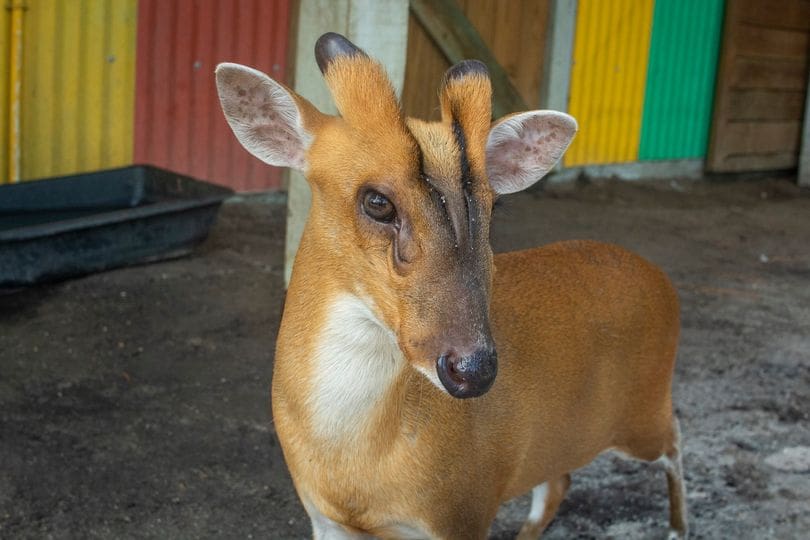Summary of Meet the Animal: Reeve’s Muntjacs:
This content highlights Kirby, a male Reeve’s Muntjac residing at the Brevard Zoo. The article explains that muntjacs are small deer known for their unique features, such as preorbital scent glands near their eyes. They use these glands to communicate with other deer. Kirby is described as shy and often goes unnoticed by visitors. He is paired with another muntjac named Harriet for breeding purposes, in line with conservation efforts. The article also mentions Kirby’s friendship with a male emu named Pedro. The keepers are tracking Harriet’s behaviors and preparing for a potential pregnancy. Additionally, the article mentions that muntjacs are most active at dawn and dusk but will forego their usual sleep patterns for food. The article concludes with the Hope for a new fawn in 2024.
Summary:
– The Brevard Zoo has a “Meet the Animals” section to introduce visitors to some of their more elusive residents, such as the Reeve’s Muntjacs.
– Reeve’s Muntjacs, also known as barking deer, have unique features like preorbital scent glands and fangs.
– Harriet and Kirby, the two Reeve’s Muntjacs at the zoo, have become inseparable and are being paired for breeding.
– The zoo’s keepers have been preparing for the possibility of a muntjac pregnancy and have trained Harriet for voluntary ultrasounds.
– Muntjacs are crepuscular, meaning they are most active at dawn and dusk but are also motivated by food.
If you’ve ever visited the Brevard Zoo, you’ve probably encountered some of its more than 900 animal residents. While some of these animals are easy to spot, others may be elusive due to their habitat setup, personalities, sleep cycles, or other reasons. That’s why the zoo has a special “Meet the Animals” section on its blog to introduce visitors to some of these lesser-known residents. In this blog post, we’ll look at the unique and fascinating aspects of Meet the Animal: Reeve’s Muntjacs.
The unofficial stars in the zoo’s Lands of Change loop are undoubtedly the kangaroo mob members. With all the recent excitement surrounding Lilly’s new joey and the adorable antics of Hope, it can be easy to overlook other animal residents who call the Kangaroo Walkabout home. However, the next time you see a fleeting flash of brown run past you on the sandy trail, rest assured that it wasn’t your imagination. It was likely one of the two Reeve’s Muntjacs, Harriet or Kirby. Due to their shy personalities and slight stature, these deer often go unnoticed by the average zoo-goer.
Now, you might be wondering, what exactly are Muntjacs? Well, you’ve come to the right place for answers. Muntjacs, sometimes referred to as barking deer, are a type of small deer known for some unique features. One of the most striking features of Muntjacs is the “holes” near their eyes called preorbital scent glands. These glands primarily serve as a means of communication with other deer. By being licked, rubbed on objects, or even while using the restroom, they can convey various information to their fellow deer. These signals might pertain to territory, reproductive readiness, personal identification, or the presence of a nearby predator. Additionally, male Muntjacs are known for their fangs, which they use for defense purposes, and their stumpy antlers that shed annually. These distinctive traits have been characteristic of the species since prehistoric times, as Muntjacs are considered one of the oldest species of deer.
Harriet and Kirby, the two Reeve’s Muntjacs at the Brevard Zoo, have become inseparable since they first met. According to Alyssa Padmos, a Lands of Change exhibit keeper, deer are described as “charismatic individuals once you get to know them.” Although they can be timid, their curiosity often gets the best of them. Alyssa also mentioned that Kirby has developed a fondness for Pedro, one of the male emus at the zoo. If you’re lucky, you might even catch them resting together.
For avid Muntjac fans, there’s exciting news. Harriet and Kirby are being paired for breeding as per the Association of Zoos and Aquariums’ Species Survival Plan (SSP) recommendation. This program aims to ensure animal populations’ health and genetic diversity in AZA-accredited facilities. While this species of Muntjac is not considered endangered, breeding them can help increase genetic diversity and encourage people to learn more about Muntjac conservation efforts. Alyssa mentioned, “When Harriet joined us this past Spring, Kirby was immediately smitten. They have been inseparable since day one!”
Although Harriet is not yet pregnant, the zookeepers have been preparing for the possibility of a new fawn. They have been monitoring Harriet’s behaviors and training her for voluntary ultrasounds. At the Brevard Zoo, animals are given choice and control in all their activities. The animal care teams can monitor a resident’s health without resorting to more invasive methods through training and familiarity with medical procedures like ultrasounds. In the event of a Muntjac pregnancy, the keepers have plans in place, including creating a quiet and cozy space in the side yard where Harriet can give birth in privacy and comfort.
Now that you’ve discovered Reeve’s Muntjacs and their fascinating features, you might be eager to observe Harriet and Kirby’s antics. However, this may be a challenge since, like other deer, Muntjacs are crepuscular. This means they are most active at dawn and dusk. However, nap time is abandoned for a quick snack when food comes into play. Harriet loves peanuts, while Kirby has a taste for corn from the kangaroos’ stash.
Let’s keep our hooves crossed for a new Muntjac fawn in 2024! In the meantime, watch for these shy and unique residents on your next visit to the Brevard Zoo. And remember, even though some animals may go unnoticed, they are all essential to the zoo’s diverse and fascinating animal kingdom.

